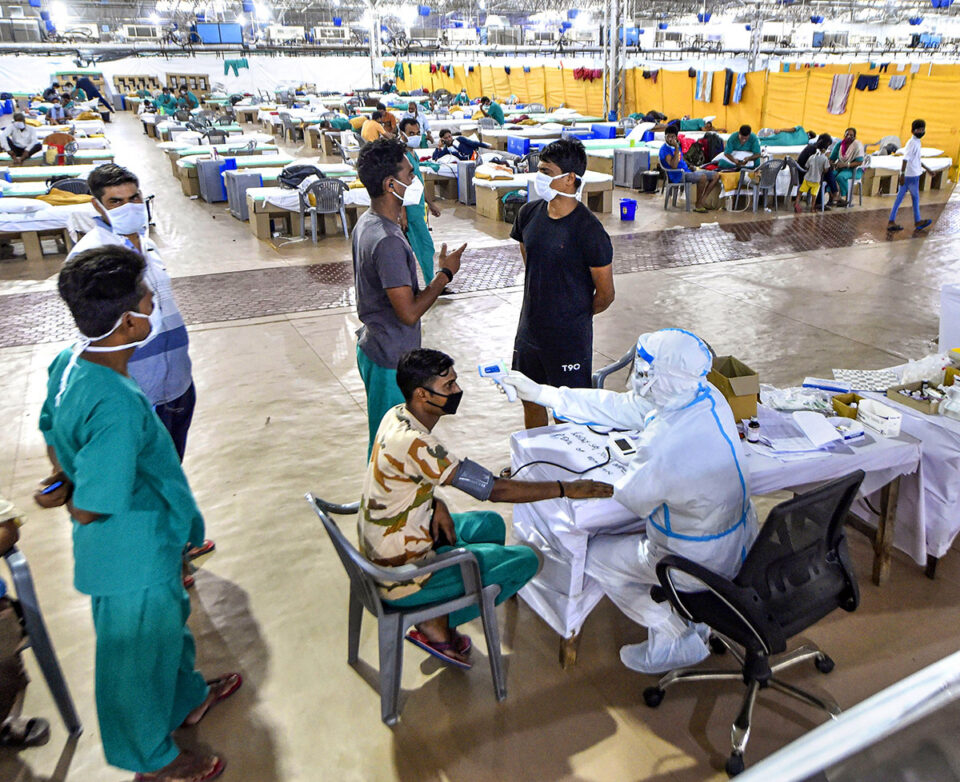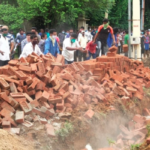The health ministry on Tuesday said the positivity rate of COVID-19 has come down from 10.03 per cent to 7.72 per cent despite sustained level of testing.
IMAGE: A doctor checks the temperature of patients at Sardar Patel Covid Care Centre in New Delhi. Photograph: Ravi Choudhary/PTI Photo
Addressing a press briefing, health secretary Rajesh Bhushan gave five major highlights of the past week.
“An important part is recovered patients are nearly 20 lakh which is 2.93 times of active cases,” Bhushan said.
The total number of active cases is 6,73,166, while the total number of recovered cases is 19,77,779, he said.
“In the first week of April, the recovery rate was around 7.35 per cent and presently it has increased to 73.18 per cent,” he said.
The average daily recovered cases are now more than 55,000 and active cases are just 25 per cent of the total COVID cases which means just 25 per cent of the cases are either in hospital or home isolation, he said.
“Another important point to note here is that in spite of a sustained level of 7 lakh to 8 lakh tests a day, the positivity figure has come down from 10.03 per cent to 7.72 per cent,” he said.
The graph presented by him showed that the positivity rate was 10.03 per cent between July 8 and 14 and it has come down to 7.72 per cent between August 12 and 18.
Bhushan said more than 3 crore tests have been conducted and for the first time, 8,99,864 tests were conducted in the last 24 hours which is a new peak.
On case fatality rate, Bhushan said it has come below 2 per cent now.
“The case fatality rate (as per weekly average) in July first week was 2.89 per cent. Now it (weekly average) has come down to 1.94 per cent and daily case fatality rate is 1.92 per cent. Our target is to bring it down to 1 per cent or lesser,” Bhushan said.
He said the health ministry has repeatedly underlined the fact in its interaction with state governments and UTs that the aim should be to bring down the fatality rate to 1 per cent or below 1 per cent.
On testing, Bhushan said in the first week of July (July 1 to 7) nearly 2,30,751 tests were conducted and now that number has increased to 8,08,488 (August 12 to 18).
“If we look at the week-wise trend of testing of COVID-19, we will find that in the first week of July (July 1 to 7) nearly 2,30,751 tests were conducted and now that number has increased to 8,08,488 (August 12 to 18) and in the last 24 hours, we conducted record number of tests at 8,99,864,” he said.
Bhushan presented a pie chart that showed the overall percentage of COVID cases in three different categories.
The pie chart showed 73.18 per cent of the total cases have recovered or discharged while 24.91 per cent of the total cases are active and 1.92 per cent were deaths.
“All these results are because we are conducting a very high number of tests every day using both RT-PCR and rapid antigen tests. Both the tests have a role to play. Through a high number of testing we are able to identify the cases fast… When cases are identified early they can be taken to hospitals early because of all that the recovery rate is also rising,” he said.




